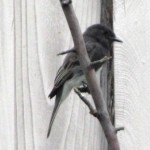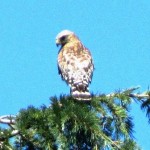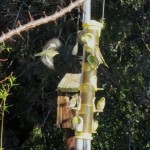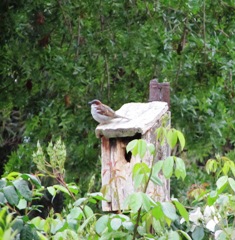How to Attract Birds to Make Your Garden a Sanctuary
A Chinese proverb states that “If I keep a green bough in my heart, then the singing bird will come.” I think I was born with that green bough in my heart because I have always loved birds–and not only the songbirds.
By offering food, water, and safe and dry housing as well as blooms for every season (flowering annuals, perennials, herbs, bulbs, and fruits and berries), I am able to attract many different birds into my garden.When birds are present, especially the songbirds, the garden becomes a special sanctuary.
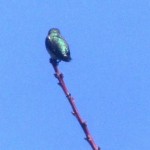
A hummer’s iridescent feathers shimmer as it perches in sunlight at the end of an apricot tree branch
I hang feeders and fill them with various types of seed and suet cakes as well as syrup for hummingbirds. Food attracts local and migratory birds flying through this time of year. It’s best to choose a wide sampling of foods such as seeds, nuts,hulled sunflower, safflower, Nyjer thistle, peanut, millet, fruit, berries, raisins, and meal worms to draw interesting bird traffic.
Some of the birds we regularly see include scrub jays, wrens, finches, sparrows, red-tail hawks, mockingbirds, quail, mourning doves, robins, barn owls, hummingbirds, and crows.
With food scarce in the wild, the birds visit the hanging and platform feeders. For ground feeders like mourning doves, I put out a large saucer under the apple tree and, yes, I leave a few apples on the tree for the birds to peck. For a list of birds and the types of seed and other foods they consume, see, https://www.wild-bird-watching.com/Bird_Seed.html
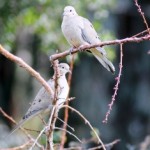
Mourning doves mate for life; these two are joined at the feeder by a third who has lost his or her partner
Some of our winged visitors stick around to mate and build nests in climbing rose bushes, brush piles, trees, or one of the many birdhouses we’ve hung. Only the owl basket high in the pepper tree remains empty, but we’ve heard a lot of hooting at night so we’re optimistic that owls will take up residence here. We live close to designated agricultural lands and the empty field behind us has a lot of mice–their favorite food.

My hubby built this birdhouse from a fence board. Not all birds will take up residence in a house, but many will.
Birds build nests in backyard birdhouses and brush piles as well as in trees, shrubs like climbing roses, and under the protected eaves of buildings (mourning doves especially seem to like these). Hummingbirds will build their tiny cup-like nests in shrubs (we found one in our Cecil Brunner climbing rose bush) and trees, from 10 feet and up in locations where wind isn’t a threat.
A water source is important for attracting birds since they both drink and bathe in the water fountains and bird baths of backyards and gardens.
If you provide food, water, and a safe and dry shelter for the birds to eat, breed, and nest, you will be rewarded for not only the singing birds will come but other interesting species as well.
_______________________________________________________
If you enjoy reading about living close to the earth and a good yarn, check out my Henny Penny Farmette series of cozy mysteries: A BEELINE TO MURDER, THE MURDER OF A QUEEN BEE, and my latest, A HIVE OF HOMICIDES.
These mysteries are chock-full of tips for keeping chickens and bees, growing heirloom fruits and vegetables, and backyard DIY projects. For more information, click on the URL.
A HIVE OF HOMICIDES
Is He or Isn’t He a Brown-headed Nuthatch?
I’ve been checking out the photos of birds I’ve taken since moving to the Henny Penny Farmette. I’ve been able to identify most of them, but one took a while for me to figure out. Like other birds that come by for a visit, he perched for a spell atop the rough-hewn birdhouse on the back fence. I think he is a brown-headed nuthatch (sitta pusilla), although I am not completely convinced I’m right. Half the fun of being a bird watcher is figuring out what species you have spotted.
Still, the bird has the right markings–the brown cap down to the eye, white nape spot, white throat and underparts, and some gray on its back. With beady eyes, broad shoulders, and a short neck, this little bird seems to best fit the description of the brown-headed nuthatch although that species likes the pine forests of the southern United States and travels in flocks. This fellow showed up alone in my Northern California garden.
I got out my Audubon Society bird guidebook and the Song and Garden Birds of North America, a National Geographic book, to help me identify the nuthatch and some of our other feathered friends. So far, we’ve had visits by sparrows, finches, scrub jays, a pair of Western bluebirds, mourning doves, wrens, a barn owl, lots of hawks and crows, and hummingbirds.
We’ve put up birdhouses, some with rough bark exteriors, that seem to attract certain types of birds. Other birdhouses are smooth surfaced. The bluebirds were checking out one of those today. Spring will come . . . eventually, but even before trees start to break bud, the birds will be scouting nesting sites. I’m hoping the brown-headed nuthatch will return with a mate and stay around for a while.
 Facebook
Facebook Goodreads
Goodreads LinkedIn
LinkedIn Meera Lester
Meera Lester Twitter
Twitter





